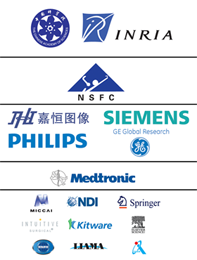Title: Network Analysis of Cortical Anatomy
Abstract:
Graph theory has been employed in many fields to understand networked interactions. This talk will describe recent activity in brain network modeling with emphasis on anatomical correlation analysis. Network modeling provides indices of brain organization, both long-range and local processing, and the associated anatomical infrastructure. The different imaging modalities of structural MRI and DTI provide complementary information on overall network efficiency and allow for the identification of sub-networks that may subserve specific behavioral domains This talk will describe the basic methodologies of network analysis, the image analysis issues which influence the extraction of network components and the application of network analysis in neurodevelopment and neurodegeneration.
Biography:
Professor Alan Evans did his undergraduate training in physics at Liverpool University in the U.K. He completed his PhD in biophysics, studying the 3D folding patterns of protein structure and the binding of co-factors and substrates to enzymes. He then spent 5-year at Atomic Energy of Canada Ltd. in Ottawa, working on the physics and biochemical analysis of positron emission tomography (PET) data.
In 1984, he moved to the Montreal Neurological Institute (MNI) at McGill University in Montreal to continue his PET research. His research interests include multi-modal brain imaging with PET and MRI, image processing and large-scale brain database analysis.
He has published 350+ peer-reviewed papers and holds numerous NIH and CIHR grants. During his 25 years at the MNI, he has held numerous leadership roles, most notably as director of the McConnell Brain Imaging Centre (BIC) during the 1990’s. Dr. Evans is a founding member of the International Consortium for Brain Mapping (ICBM). He was one of the founders of the Organization for Human Brain Mapping (OHBM), serving in numerous positions on the OHBM Council since 1995. He chaired the 4th International Conference on Human Brain Mapping in 1998. He is a regular participant in numerous NIH workshops, panels and initiatives related to brain imaging research. He is on the scientific advisory board of numerous research programs in this field. In 2003 he received a Senior Scientist Award from the Canadian Institutes of Health Research.
Dr. Evans heads the data coordinating center for a large NIH-funded multi-center MRI study of normal pediatric development. This project provides a web-accessible reference database of normal maturation, both neuroanatomical and behavioral, for studies of normal and abnormal brain development. The methodologies developed for that project, most notably (i) the web-based imaging/behavioral database, (ii) the automated MRI segmentation pipeline, and (iii) the brain-behavior correlation analysis for voxel-based (volumetric) or vertex-based (surface) data, are being used in a series of network collaborations on abnormal pediatric development (MAVAN, IBIS, NeuroDevNet, GUSTO) and two multi-centre European initiatives to investigate Alzheimer’s Disease (AddNeuroMed and NeuGrid). He heads two initiatives to develop grid-processing of large brain databases, both nationally (CBRAIN) and internationally (GBRAIN).
He is Founder and Director of Biospective Inc., (www.biospective.com) a Montreal-based company that specializes in image analysis for clinical and pre-clinical pharmaceutical studies.
|
|
Title: Snake and Lobster – A Feast for MICCAI?
Abstract:
Reduced patient trauma and recovery time combined with improved precision and dexterity for micro-scale tasks are major benefits of robotic assisted Minimal Invasive Surgery (MIS). The purpose of this presentation is to outline key clinical challenges and research opportunities for the MICCAI community in developing biomimetic robotic systems integrated with in situ, in vivo imaging and sensing towards the future evolution of MIS based on truly flexible access technologies. The talk will cover the latest developments in fully articulated, bio-inspired (e.g. Snake) robot platforms that facilitate intra-luminal or extra-luminal anatomical curved pathway navigation with integrated sensing and navigation. It addresses key theoretical considerations of bio-mimetic control for intra-operative manipulation under dynamic local/global constraints, as well as the current paradigm shift and clinical demand for bringing cellular and molecular imaging modalities to an in vivo, in situ setting to allow for real-time tissue characterization, functional assessment, and intraoperative guidance. The talk will discuss new bio-photonics techniques based on excitation/emission spectral resolution suitable for endoscopy and laparoscopy and some of the new research opportunities on image fusion, visualization and mechatronic designs. Issues concerning effective, natural human-robot interface are discussed and example implementations for these highly redundant robot platforms based on the concept of perceptual docking are provided. Through this ‘feast’ of new technological developments and challenges, the talk will highlight the role of MICCAI in reshaping the future of MIS, particularly the clinical pursuit of Natural Orifice Transluminal Endoscopic Surgery (NOTES) and Single Incision Laparoscopic Surgery (SILS).
Biography:
Professor Guang-Zhong Yang received BSc in Electrical and Electronic Engineering from Shanghai Jiao Tong University and Ph.D. in Computer Science from Imperial College London. He served as a senior and then principal scientist of the Cardiovascular Magnetic Resonance Unit of the Royal Brompton Hospital, England before returning to Imperial College. He is Director and Founder of the Royal Society/Wolfson Medical Image Computing Laboratory, co-founder of the Wolfson Surgical Technology Laboratory at Imperial, and co-founder and director of the Hamlyn Centre for Robotic Surgery. He is also head of the VIP (Visual Information Processing) Group and research director of the Institute of Biomedical Engineering, Imperial College London. Professor Yang’s main research interests are in medical imaging, sensing and robotics. In imaging, he is credited for a number of novel MR phase contrast velocity imaging and computational modeling techniques that have transformed in vivo blood flow quantification and visualization. These include the development of locally focused imaging combined with real-time navigator echoes for resolving respiratory motion for high-resolution coronary-angiography, as well as MR dynamic flow pressure mapping for which he received the ISMRM I. I Rabi Award. In medical robotics, he pioneered the concept of Perceptual Docking for robotic assisted minimally invasive surgery. The work represents a fundamental paradigm shift of learning and knowledge acquisition for robotics in that operator specific motor and perceptual/cognitive behavior is assimilated in situ, thus allowing seamless integration of machine precision with human intelligence. He is Fellow of IET, AIMBE and a holder of the Royal Society Research Merit Award. He has published over 300 original, peer reviewed research articles including over 150 academic journal papers. He was the General Chair of MICCAI 2009, held in London, England last year.
|





